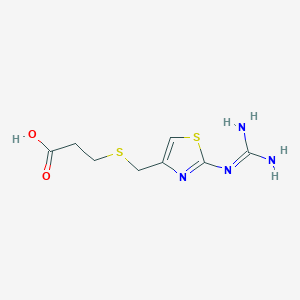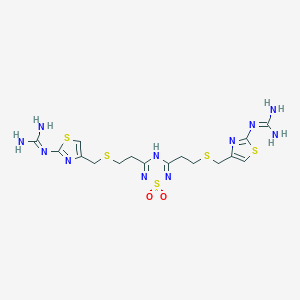
フルドロコルチゾン
概要
説明
フルドロコルチゾンは、強力なミネラルコルチコイド作用を持つ合成コルチコステロイドです。 主に副腎皮質機能不全や塩分喪失性副腎生殖器症候群などの治療に使用されます 。 フルドロコルチゾンは、体内に自然に存在するホルモンであるアルドステロンの作用を模倣し、コルチゾールと構造的に類似しています .
作用機序
科学的研究の応用
Fludrocortisone has a wide range of scientific research applications:
Chemistry: It is used as a model compound to study the effects of fluorination on steroid activity.
Medicine: It is used to treat conditions such as Addison’s disease and salt-losing adrenogenital syndrome.
準備方法
フルドロコルチゾンは、コルチゾールから始まる一連の化学反応によって合成されます。 フルドロコルチゾン酢酸エステルの工業生産には、スプレー乾燥法を用いて化合物の固体分散体を作成することが含まれます .
化学反応の分析
フルドロコルチゾンは、次のようなさまざまな化学反応を受けます。
酸化: フルドロコルチゾンは、3-ケト-フルドロコルチゾンとそのテトラヒドロおよびジヒドロ代謝産物に酸化される可能性があります.
還元: 還元反応は、フルドロコルチゾンをより弱力な代謝産物に変換することができます。
これらの反応で使用される一般的な試薬および条件には、酸化のための強い酸化剤と還元のための還元剤が含まれます。 これらの反応から生成される主要な生成物は、さまざまなフルドロコルチゾンの代謝産物であり、それぞれ異なる効力を持っています .
科学研究への応用
フルドロコルチゾンは、幅広い科学研究に応用されています。
化学: ステロイド活性に対するフッ素化の影響を研究するためのモデル化合物として使用されます。
生物学: フルドロコルチゾンは、ミネラルコルチコイドが電解質バランスと血圧調節において果たす役割を調べるために使用されます.
類似化合物との比較
フルドロコルチゾンは、その高いミネラルコルチコイド効力により、コルチコステロイドの中でユニークです。類似化合物には以下が含まれます。
アルドステロン: 体内の主要な内因性ミネラルコルチコイドであり、作用機序は類似していますが、ナトリウム貯留の点ではより強力です.
ヒドロコルチゾン: ある程度のミネラルコルチコイド活性を示すグルココルチコイドであり、副腎不全の治療のためにフルドロコルチゾンと組み合わせて使用されます.
プレドニゾンとプレドニゾロン: グルココルチコイド活性とミネラルコルチコイド活性の両方を持つ中長時間の作用をするコルチコステロイドです.
フルドロコルチゾンのユニークさは、その構造的修飾(フッ素化)にあり、他のコルチコステロイドに比べてそのミネラルコルチコイド活性を大幅に高めています .
特性
IUPAC Name |
(8S,9R,10S,11S,13S,14S,17R)-9-fluoro-11,17-dihydroxy-17-(2-hydroxyacetyl)-10,13-dimethyl-1,2,6,7,8,11,12,14,15,16-decahydrocyclopenta[a]phenanthren-3-one | |
|---|---|---|
| Source | PubChem | |
| URL | https://pubchem.ncbi.nlm.nih.gov | |
| Description | Data deposited in or computed by PubChem | |
InChI |
InChI=1S/C21H29FO5/c1-18-7-5-13(24)9-12(18)3-4-15-14-6-8-20(27,17(26)11-23)19(14,2)10-16(25)21(15,18)22/h9,14-16,23,25,27H,3-8,10-11H2,1-2H3/t14-,15-,16-,18-,19-,20-,21-/m0/s1 | |
| Source | PubChem | |
| URL | https://pubchem.ncbi.nlm.nih.gov | |
| Description | Data deposited in or computed by PubChem | |
InChI Key |
AAXVEMMRQDVLJB-BULBTXNYSA-N | |
| Source | PubChem | |
| URL | https://pubchem.ncbi.nlm.nih.gov | |
| Description | Data deposited in or computed by PubChem | |
Canonical SMILES |
CC12CCC(=O)C=C1CCC3C2(C(CC4(C3CCC4(C(=O)CO)O)C)O)F | |
| Source | PubChem | |
| URL | https://pubchem.ncbi.nlm.nih.gov | |
| Description | Data deposited in or computed by PubChem | |
Isomeric SMILES |
C[C@]12CCC(=O)C=C1CC[C@@H]3[C@@]2([C@H](C[C@]4([C@H]3CC[C@@]4(C(=O)CO)O)C)O)F | |
| Source | PubChem | |
| URL | https://pubchem.ncbi.nlm.nih.gov | |
| Description | Data deposited in or computed by PubChem | |
Molecular Formula |
C21H29FO5 | |
| Source | PubChem | |
| URL | https://pubchem.ncbi.nlm.nih.gov | |
| Description | Data deposited in or computed by PubChem | |
DSSTOX Substance ID |
DTXSID7023061 | |
| Record name | Fludrocortisone | |
| Source | EPA DSSTox | |
| URL | https://comptox.epa.gov/dashboard/DTXSID7023061 | |
| Description | DSSTox provides a high quality public chemistry resource for supporting improved predictive toxicology. | |
Molecular Weight |
380.4 g/mol | |
| Source | PubChem | |
| URL | https://pubchem.ncbi.nlm.nih.gov | |
| Description | Data deposited in or computed by PubChem | |
Physical Description |
Solid | |
| Record name | Fludrocortisone | |
| Source | Human Metabolome Database (HMDB) | |
| URL | http://www.hmdb.ca/metabolites/HMDB0014825 | |
| Description | The Human Metabolome Database (HMDB) is a freely available electronic database containing detailed information about small molecule metabolites found in the human body. | |
| Explanation | HMDB is offered to the public as a freely available resource. Use and re-distribution of the data, in whole or in part, for commercial purposes requires explicit permission of the authors and explicit acknowledgment of the source material (HMDB) and the original publication (see the HMDB citing page). We ask that users who download significant portions of the database cite the HMDB paper in any resulting publications. | |
Solubility |
In water, 140 mg/L at 25 °C, 2.24e-01 g/L | |
| Record name | FLUDROCORTISONE | |
| Source | Hazardous Substances Data Bank (HSDB) | |
| URL | https://pubchem.ncbi.nlm.nih.gov/source/hsdb/3332 | |
| Description | The Hazardous Substances Data Bank (HSDB) is a toxicology database that focuses on the toxicology of potentially hazardous chemicals. It provides information on human exposure, industrial hygiene, emergency handling procedures, environmental fate, regulatory requirements, nanomaterials, and related areas. The information in HSDB has been assessed by a Scientific Review Panel. | |
| Record name | Fludrocortisone | |
| Source | Human Metabolome Database (HMDB) | |
| URL | http://www.hmdb.ca/metabolites/HMDB0014825 | |
| Description | The Human Metabolome Database (HMDB) is a freely available electronic database containing detailed information about small molecule metabolites found in the human body. | |
| Explanation | HMDB is offered to the public as a freely available resource. Use and re-distribution of the data, in whole or in part, for commercial purposes requires explicit permission of the authors and explicit acknowledgment of the source material (HMDB) and the original publication (see the HMDB citing page). We ask that users who download significant portions of the database cite the HMDB paper in any resulting publications. | |
Mechanism of Action |
The main endogenous mineralocorticoid, aldosterone, is produced in the zona glomerulosa of the adrenal cortex - it acts on mineralocorticoid receptors in the kidneys to increase sodium reabsorption and potassium excretion, which in turn helps to regulate plasma electrolyte composition and blood pressure. In conditions of adrenal insufficiency, such as Addison’s disease, aldosterone is not produced (or is produced in insufficient quantities) and must be replaced by exogenous mineralocorticoids such as fludrocortisone. Fludrocortisone binding to mineralocorticoid receptors causes alterations to DNA transcription and translation of proteins that result in an increased density of sodium channels on the apical side of renal tubule cells and an increased density of Na+-K+-ATPase on the basolateral side. These increases in receptor density result in increased plasma sodium concentrations, and thus increased blood pressure, as well as a decreased plasma potassium concentration. Fludrocortisone may also exert a direct effect on plasma sodium levels via action at the Na+-H+ exchanger found in the apical membrane of renal tubule cells. Fludrocortisone also acts on glucocorticoid receptors, albeit with a much lower affinity - the glucocorticoid potency of fludrocortisone is approximately 5-10 times that of endogenous cortisol, whereas its mineralocorticoid potency is 200-400 times greater., At the cellular level, corticosteroids diffuse across cell membranes and complex with specific cytoplasmic receptors. These complexes then enter the cell nucleus, bind to DNA (chromatin), and stimulate transcription of mRNA (messenger RNA) and subsequent protein synthesis of various enzymes thought to be ultimately responsible for the physiological effects of these hormones., Mineralocorticoids act on the distal tubules to increase potassium excretion, hydrogen ion excretion, and sodium reabsorption and subsequent water retention. Cation transport in other secretory cells is similarly affected; excretion of water and electrolytes by the large intestine and by salivary and sweat glands is also altered, but to a lesser extent. | |
| Record name | Fludrocortisone | |
| Source | DrugBank | |
| URL | https://www.drugbank.ca/drugs/DB00687 | |
| Description | The DrugBank database is a unique bioinformatics and cheminformatics resource that combines detailed drug (i.e. chemical, pharmacological and pharmaceutical) data with comprehensive drug target (i.e. sequence, structure, and pathway) information. | |
| Explanation | Creative Common's Attribution-NonCommercial 4.0 International License (http://creativecommons.org/licenses/by-nc/4.0/legalcode) | |
| Record name | FLUDROCORTISONE | |
| Source | Hazardous Substances Data Bank (HSDB) | |
| URL | https://pubchem.ncbi.nlm.nih.gov/source/hsdb/3332 | |
| Description | The Hazardous Substances Data Bank (HSDB) is a toxicology database that focuses on the toxicology of potentially hazardous chemicals. It provides information on human exposure, industrial hygiene, emergency handling procedures, environmental fate, regulatory requirements, nanomaterials, and related areas. The information in HSDB has been assessed by a Scientific Review Panel. | |
Color/Form |
Crystals | |
CAS No. |
127-31-1 | |
| Record name | Fludrocortisone | |
| Source | CAS Common Chemistry | |
| URL | https://commonchemistry.cas.org/detail?cas_rn=127-31-1 | |
| Description | CAS Common Chemistry is an open community resource for accessing chemical information. Nearly 500,000 chemical substances from CAS REGISTRY cover areas of community interest, including common and frequently regulated chemicals, and those relevant to high school and undergraduate chemistry classes. This chemical information, curated by our expert scientists, is provided in alignment with our mission as a division of the American Chemical Society. | |
| Explanation | The data from CAS Common Chemistry is provided under a CC-BY-NC 4.0 license, unless otherwise stated. | |
| Record name | Fludrocortisone [INN:BAN] | |
| Source | ChemIDplus | |
| URL | https://pubchem.ncbi.nlm.nih.gov/substance/?source=chemidplus&sourceid=0000127311 | |
| Description | ChemIDplus is a free, web search system that provides access to the structure and nomenclature authority files used for the identification of chemical substances cited in National Library of Medicine (NLM) databases, including the TOXNET system. | |
| Record name | Fludrocortisone | |
| Source | DrugBank | |
| URL | https://www.drugbank.ca/drugs/DB00687 | |
| Description | The DrugBank database is a unique bioinformatics and cheminformatics resource that combines detailed drug (i.e. chemical, pharmacological and pharmaceutical) data with comprehensive drug target (i.e. sequence, structure, and pathway) information. | |
| Explanation | Creative Common's Attribution-NonCommercial 4.0 International License (http://creativecommons.org/licenses/by-nc/4.0/legalcode) | |
| Record name | fludrocortisone | |
| Source | DTP/NCI | |
| URL | https://dtp.cancer.gov/dtpstandard/servlet/dwindex?searchtype=NSC&outputformat=html&searchlist=11318 | |
| Description | The NCI Development Therapeutics Program (DTP) provides services and resources to the academic and private-sector research communities worldwide to facilitate the discovery and development of new cancer therapeutic agents. | |
| Explanation | Unless otherwise indicated, all text within NCI products is free of copyright and may be reused without our permission. Credit the National Cancer Institute as the source. | |
| Record name | Fludrocortisone | |
| Source | EPA DSSTox | |
| URL | https://comptox.epa.gov/dashboard/DTXSID7023061 | |
| Description | DSSTox provides a high quality public chemistry resource for supporting improved predictive toxicology. | |
| Record name | Fludrocortisone | |
| Source | European Chemicals Agency (ECHA) | |
| URL | https://echa.europa.eu/substance-information/-/substanceinfo/100.004.395 | |
| Description | The European Chemicals Agency (ECHA) is an agency of the European Union which is the driving force among regulatory authorities in implementing the EU's groundbreaking chemicals legislation for the benefit of human health and the environment as well as for innovation and competitiveness. | |
| Explanation | Use of the information, documents and data from the ECHA website is subject to the terms and conditions of this Legal Notice, and subject to other binding limitations provided for under applicable law, the information, documents and data made available on the ECHA website may be reproduced, distributed and/or used, totally or in part, for non-commercial purposes provided that ECHA is acknowledged as the source: "Source: European Chemicals Agency, http://echa.europa.eu/". Such acknowledgement must be included in each copy of the material. ECHA permits and encourages organisations and individuals to create links to the ECHA website under the following cumulative conditions: Links can only be made to webpages that provide a link to the Legal Notice page. | |
| Record name | FLUDROCORTISONE | |
| Source | FDA Global Substance Registration System (GSRS) | |
| URL | https://gsrs.ncats.nih.gov/ginas/app/beta/substances/U0476M545B | |
| Description | The FDA Global Substance Registration System (GSRS) enables the efficient and accurate exchange of information on what substances are in regulated products. Instead of relying on names, which vary across regulatory domains, countries, and regions, the GSRS knowledge base makes it possible for substances to be defined by standardized, scientific descriptions. | |
| Explanation | Unless otherwise noted, the contents of the FDA website (www.fda.gov), both text and graphics, are not copyrighted. They are in the public domain and may be republished, reprinted and otherwise used freely by anyone without the need to obtain permission from FDA. Credit to the U.S. Food and Drug Administration as the source is appreciated but not required. | |
| Record name | FLUDROCORTISONE | |
| Source | Hazardous Substances Data Bank (HSDB) | |
| URL | https://pubchem.ncbi.nlm.nih.gov/source/hsdb/3332 | |
| Description | The Hazardous Substances Data Bank (HSDB) is a toxicology database that focuses on the toxicology of potentially hazardous chemicals. It provides information on human exposure, industrial hygiene, emergency handling procedures, environmental fate, regulatory requirements, nanomaterials, and related areas. The information in HSDB has been assessed by a Scientific Review Panel. | |
| Record name | Fludrocortisone | |
| Source | Human Metabolome Database (HMDB) | |
| URL | http://www.hmdb.ca/metabolites/HMDB0014825 | |
| Description | The Human Metabolome Database (HMDB) is a freely available electronic database containing detailed information about small molecule metabolites found in the human body. | |
| Explanation | HMDB is offered to the public as a freely available resource. Use and re-distribution of the data, in whole or in part, for commercial purposes requires explicit permission of the authors and explicit acknowledgment of the source material (HMDB) and the original publication (see the HMDB citing page). We ask that users who download significant portions of the database cite the HMDB paper in any resulting publications. | |
Retrosynthesis Analysis
AI-Powered Synthesis Planning: Our tool employs the Template_relevance Pistachio, Template_relevance Bkms_metabolic, Template_relevance Pistachio_ringbreaker, Template_relevance Reaxys, Template_relevance Reaxys_biocatalysis model, leveraging a vast database of chemical reactions to predict feasible synthetic routes.
One-Step Synthesis Focus: Specifically designed for one-step synthesis, it provides concise and direct routes for your target compounds, streamlining the synthesis process.
Accurate Predictions: Utilizing the extensive PISTACHIO, BKMS_METABOLIC, PISTACHIO_RINGBREAKER, REAXYS, REAXYS_BIOCATALYSIS database, our tool offers high-accuracy predictions, reflecting the latest in chemical research and data.
Strategy Settings
| Precursor scoring | Relevance Heuristic |
|---|---|
| Min. plausibility | 0.01 |
| Model | Template_relevance |
| Template Set | Pistachio/Bkms_metabolic/Pistachio_ringbreaker/Reaxys/Reaxys_biocatalysis |
| Top-N result to add to graph | 6 |
Feasible Synthetic Routes
Q1: How does fludrocortisone exert its effects in the body?
A1: Fludrocortisone is a synthetic mineralocorticoid, primarily acting as an analog of aldosterone. It binds to the mineralocorticoid receptor (MR) in the distal tubules of the kidney, promoting sodium reabsorption and increasing the excretion of potassium and hydrogen ions. [, , , ] This action leads to increased plasma volume, contributing to increased blood pressure, making it clinically relevant for managing conditions like postural hypotension and adrenal insufficiency. [, , , ]
Q2: Can fludrocortisone's glucocorticoid activity contribute to its clinical effects?
A2: While fludrocortisone primarily acts as a mineralocorticoid, it also possesses glucocorticoid activity, though significantly less potent than its mineralocorticoid effects. [, ] This glucocorticoid activity becomes particularly relevant at higher doses, as seen in the treatment of postural hypotension, where it may contribute to side effects like posterior subcapsular cataract formation. []
Q3: How does fludrocortisone impact potassium levels?
A3: Fludrocortisone's interaction with MR in the distal tubules promotes potassium excretion. This effect can lead to hypokalemia, especially with prolonged use or high doses. [, , , , , , ] Monitoring potassium levels is crucial during fludrocortisone therapy. [, ]
Q4: What is the chemical structure of fludrocortisone?
A4: Fludrocortisone is a synthetic halogenated derivative of hydrocortisone, specifically 9α-Fluorohydrocortisone. Its chemical formula is C21H29FO5.
Q5: What are the common clinical uses of fludrocortisone?
A5: Fludrocortisone is used in the management of:
- Primary adrenocortical insufficiency (Addison's disease): Supplementing mineralocorticoid deficiency. [, ]
- Postural hypotension (orthostatic hypotension): Increasing blood volume to alleviate symptoms. [, , , , ]
- Cerebral salt wasting syndrome (CSWS): Correcting hyponatremia by promoting sodium reabsorption. [, ]
Q6: Are there differences in the effectiveness of fludrocortisone compared to other treatments for orthostatic hypotension?
A7: Evidence comparing fludrocortisone to other treatments for orthostatic hypotension, such as midodrine or droxidopa, remains limited. Some studies suggest that while fludrocortisone may be effective, it might be associated with a higher risk of side effects, particularly in elderly patients or those with pre-existing conditions like congestive heart failure. [, , , , ]
Q7: Is fludrocortisone effective in managing hyperkalemia in hemodialysis patients?
A8: A randomized controlled trial investigated the use of fludrocortisone for hyperkalemia in hemodialysis patients. [] While the treatment was safe and well-tolerated, it did not demonstrate clinically significant reductions in serum potassium levels. []
Q8: What is the role of fludrocortisone in managing subarachnoid hemorrhage (SAH)?
A9: Fludrocortisone has been investigated for its potential to prevent hyponatremia and subsequent complications in patients with SAH. [, , ] Some studies suggest that early administration of fludrocortisone, particularly in patients with increased urinary sodium excretion, may reduce the incidence of symptomatic cerebral vasospasm. []
Q9: What are the potential adverse effects associated with fludrocortisone?
A9: Potential adverse effects of fludrocortisone, particularly with prolonged use or high doses, include:
- Hypokalemia: Due to increased potassium excretion. [, , , , , , ]
- Hypertension: Due to increased sodium and water retention. [, , , , ]
- Fluid retention and edema: [, , ]
- Posterior subcapsular cataract formation: Primarily associated with the glucocorticoid activity. []
Q10: Are there any significant drug interactions with fludrocortisone?
A10: Fludrocortisone may interact with various medications, including:
- Potassium-lowering drugs (e.g., diuretics): May increase the risk of hypokalemia. []
- Corticosteroids: May increase the risk of side effects. []
Q11: What factors should clinicians consider when prescribing fludrocortisone?
A11: Clinicians should consider the following:
- Patient age: Elderly patients may be more susceptible to adverse effects. []
- Co-existing medical conditions: Conditions like congestive heart failure, hypertension, and renal insufficiency may influence treatment decisions. [, ]
- Concomitant medications: Assess for potential drug interactions. []
- Monitoring: Regular monitoring of blood pressure, electrolytes (particularly potassium), and signs of fluid retention is essential. [, , ]
試験管内研究製品の免責事項と情報
BenchChemで提示されるすべての記事および製品情報は、情報提供を目的としています。BenchChemで購入可能な製品は、生体外研究のために特別に設計されています。生体外研究は、ラテン語の "in glass" に由来し、生物体の外で行われる実験を指します。これらの製品は医薬品または薬として分類されておらず、FDAから任何の医療状態、病気、または疾患の予防、治療、または治癒のために承認されていません。これらの製品を人間または動物に体内に導入する形態は、法律により厳格に禁止されています。これらのガイドラインに従うことは、研究と実験において法的および倫理的な基準の遵守を確実にするために重要です。


![2-{[(1H-Benzimidazol-2-yl)sulfanyl]methyl}-3-methylpyridin-4(1H)-one](/img/structure/B194824.png)






![[3-[[[2-(Diaminomethyleneamino)-4-thiazolyl]methyl]thio]propionyl]sulfamide Hydrochloride](/img/structure/B194844.png)






